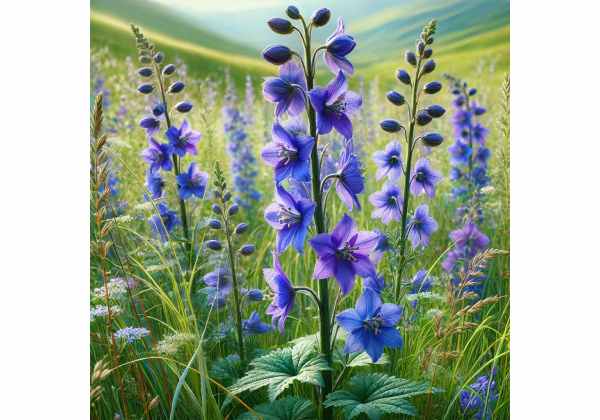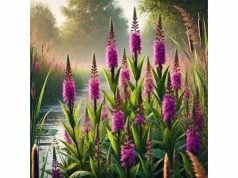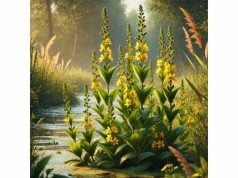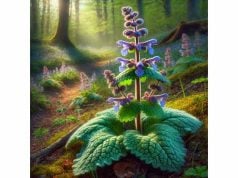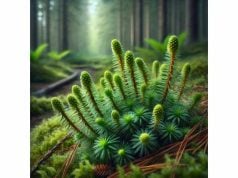Larkspur is a striking and versatile herbaceous perennial belonging primarily to the genus Delphinium within the Ranunculaceae family. Renowned for its tall, spire-like inflorescences and vibrant blooms in shades of blue, purple, pink, and white, larkspur has long been appreciated in ornamental horticulture. Beyond its aesthetic appeal, traditional herbal medicine has recognized larkspur for its potential benefits—including analgesic, anti-inflammatory, and calming effects. Its bioactive compounds, such as diterpenoid alkaloids and various flavonoids, contribute to its medicinal properties. Today, larkspur is under scientific scrutiny to validate these traditional uses while also exploring its safety profile, given its noted toxicity in certain species. This comprehensive article delves into larkspur’s botanical identity, chemical constituents, multifaceted benefits, practical applications, and the latest research findings.
Table of Contents
- Plant Profile and Identification
- Phytochemistry and Active Compounds
- Benefits and Properties
- Uses and Safety
- Scientific Research and Significant Studies
- FAQ
Plant Profile and Identification
Larkspur, commonly known by its botanical name Delphinium, represents a diverse group of flowering plants within the buttercup family (Ranunculaceae). This group encompasses over 300 species, many of which are celebrated for their elegant, tall flower spikes and richly hued blossoms. The common name “larkspur” is derived from the graceful, delicate appearance of the flowers, which some believe resemble the spurs on a lark’s foot—a poetic image that has inspired gardeners and herbalists for centuries.
Taxonomy and Botanical Classification
Larkspur belongs to the genus Delphinium, a member of the Ranunculaceae family. Historically, some species once classified under the separate genus Consolida have been merged with Delphinium, further emphasizing the group’s taxonomic complexity. Genetic and morphological studies have helped clarify the relationships among species, with key distinctions now drawn between ornamental cultivars and wild species. The diversity within this genus not only provides a wide palette of colors and forms for garden enthusiasts but also contributes to a varied phytochemical profile, influencing both aesthetic and medicinal properties.
Morphological Characteristics
Larkspur is best known for its dramatic flower spikes, which can rise to heights of 1–2 meters or more, depending on the species and growing conditions. The flowers are arranged in dense clusters along these upright stems, displaying a spectrum of colors—from deep indigos and purples to soft pastels and pure white. Each flower typically has five petals, often intricately patterned with contrasting hues and sometimes marked with speckles or streaks, enhancing their ornamental value.
The leaves of larkspur are usually deeply lobed or divided, forming a basal rosette at the plant’s base, with smaller leaves appearing along the flowering stems. These leaves are often a rich green, providing a lush backdrop to the vivid blossoms. The overall structure of larkspur is both robust and graceful, with a striking vertical emphasis that adds dramatic flair to garden landscapes.
Growth Conditions and Natural Habitat
Larkspur species thrive in temperate climates and are often found in meadows, woodlands, and along roadsides in their native regions. They prefer well-drained, fertile soils and generally require full sun to partial shade for optimal growth. In cultivation, larkspur is prized not only for its visual appeal but also for its adaptability to a range of garden settings. Gardeners often sow seeds in early spring or autumn, depending on the climate, and enjoy the rapid emergence of seedlings that quickly develop into mature plants.
In the wild, larkspur contributes to the biodiversity of its habitat by attracting a variety of pollinators, including bees, butterflies, and hummingbirds. The nectar-rich flowers are a vital food source, while the plant’s robust growth helps stabilize soil and provide shelter for small wildlife. Despite its beauty, some species of larkspur are known to be toxic—particularly to livestock—making proper identification and responsible cultivation essential.
Historical and Cultural Significance
Larkspur has a long history in both horticulture and traditional medicine. In medieval Europe, larkspur was cultivated in monastery gardens for its believed healing properties, and its vibrant blooms became symbols of youth and vitality in art and literature. Folklore often associated larkspur with love and passion, and it was sometimes used in love potions and romantic garlands.
Traditional herbal medicine has used larkspur in various forms—such as infusions, decoctions, and poultices—to treat ailments ranging from pain and inflammation to nervous system disorders. Although modern medicine has largely supplanted these practices, a renewed interest in natural remedies has led researchers to re-examine the pharmacological potential of larkspur’s active compounds.
Ecological and Economic Importance
Beyond its ornamental and medicinal roles, larkspur plays an important ecological role in supporting pollinators and maintaining natural habitats. Its flowers provide a vital food source for a range of insects, and its adaptability makes it an integral part of many native plant communities. Economically, larkspur is significant in the nursery trade, where it is cultivated for ornamental landscaping. Additionally, selective breeding has produced numerous cultivars with enhanced color, form, and disease resistance, catering to both commercial and private gardens.
In conclusion, the plant profile and identification of larkspur reveal a botanical wonder that is as diverse as it is beautiful. Its distinctive tall flower spikes, deeply lobed leaves, and varied natural habitats highlight its dual role as an ornamental treasure and a subject of medicinal interest. The following sections will explore its chemical makeup, health benefits, practical applications, and the scientific research that continues to unlock its potential.
Phytochemistry and Active Compounds
The medicinal potential of larkspur is largely driven by its rich phytochemical profile. Extensive research has identified a wide array of bioactive compounds within various parts of the plant, including its flowers, leaves, and roots. These compounds not only contribute to larkspur’s striking appearance but also underpin its diverse therapeutic effects.
- Diterpenoid Alkaloids
One of the most significant groups of compounds in larkspur is the diterpenoid alkaloids. These complex molecules are responsible for much of the plant’s biological activity. While some alkaloids in larkspur are toxic—especially in certain wild species—they have also been studied for their analgesic and anti-inflammatory properties. Research indicates that, in controlled doses, these alkaloids can modulate nerve transmission and provide pain relief. - Flavonoids
Flavonoids are a vital component of larkspur’s phytochemistry. Compounds such as quercetin, kaempferol, and luteolin are found in abundance in the plant’s flowers and leaves. These polyphenolic compounds exhibit powerful antioxidant activity, protecting cells from oxidative damage and reducing inflammation. Their vasodilatory properties also support cardiovascular health by improving blood flow and reducing blood pressure. - Phenolic Acids
Phenolic acids, including caffeic acid and ferulic acid, contribute significantly to the antioxidant capacity of larkspur. These compounds help neutralize free radicals, thereby reducing oxidative stress that can lead to chronic diseases. Additionally, phenolic acids have been linked to improved skin health and reduced inflammation. - Saponins
Saponins are glycosides known for their surfactant properties, which enhance the absorption of fat-soluble vitamins and other bioactive compounds. In larkspur, saponins contribute to its immune-enhancing and cholesterol-lowering effects. They also exhibit antimicrobial activity, which may help protect the plant from pathogens and support its traditional use in treating infections. - Tannins
Tannins are high-molecular-weight polyphenols that impart astringent properties to larkspur. They help to tighten tissues and reduce inflammation, making them useful in wound healing and skin care. Tannins also possess antimicrobial properties, adding to the plant’s overall protective benefits. - Essential Oils and Volatile Compounds
The essential oils extracted from larkspur are responsible for its characteristic aroma. These volatile compounds, which include monoterpenes and sesquiterpenes, contribute to the plant’s antimicrobial, anti-inflammatory, and calming effects. They are often used in aromatherapy to promote relaxation and alleviate respiratory discomfort. - Polysaccharides and Mucilages
Polysaccharides found in larkspur have been noted for their immune-modulating properties. They act as prebiotics, supporting the growth of beneficial gut bacteria and enhancing digestive health. Mucilaginous compounds also help soothe irritated mucous membranes, which can be beneficial in treating respiratory and gastrointestinal conditions. - Vitamins and Minerals
Although present in smaller quantities compared to secondary metabolites, vitamins (especially vitamin C) and essential minerals (such as magnesium, potassium, and calcium) in larkspur support overall cellular function, energy metabolism, and immune response.
The synergistic effects of these compounds in larkspur create a robust therapeutic profile. For instance, the combination of diterpenoid alkaloids and flavonoids not only contributes to its potent analgesic and anti-inflammatory properties but also provides a foundation for its use in managing pain and stress. Meanwhile, the antioxidant and antimicrobial actions of phenolic acids and tannins help protect cells from damage and support a healthy immune system.
Modern extraction techniques, such as high-performance liquid chromatography (HPLC) and gas chromatography-mass spectrometry (GC-MS), have enabled researchers to isolate and quantify these compounds with high precision. This rigorous phytochemical profiling is essential for standardizing larkspur extracts for medicinal use and ensuring consistent efficacy across different batches. Ongoing research aims to refine these extraction methods and explore novel applications for larkspur’s bioactive compounds, further bridging the gap between traditional herbal medicine and modern clinical practices.
Benefits and Properties
Larkspur offers a diverse range of health benefits, many of which have been recognized for centuries in traditional herbal medicine and are now supported by modern scientific research. Its unique blend of bioactive compounds works synergistically to promote well-being across multiple systems in the body.
Pain Relief and Analgesic Effects
One of the hallmark benefits of larkspur is its potential for pain relief. The diterpenoid alkaloids found in larkspur have been shown to exhibit analgesic properties by modulating nerve signals and reducing pain perception. When used appropriately, larkspur extracts may help alleviate:
- Chronic Pain: By reducing inflammation and nerve sensitivity.
- Musculoskeletal Discomfort: Offering relief from conditions such as arthritis and muscle strain.
- Headaches: Through its calming and anti-inflammatory actions.
Anti-inflammatory Action
Chronic inflammation is a major contributor to many diseases, including cardiovascular disorders, diabetes, and autoimmune conditions. Larkspur’s bioactive compounds, particularly its flavonoids and phenolic acids, play a significant role in mitigating inflammation. They achieve this by:
- Inhibiting Pro-inflammatory Cytokines: Reducing the production of inflammatory mediators.
- Protecting Tissues: Against inflammatory damage and oxidative stress.
- Supporting Joint Health: By alleviating inflammation in arthritis and related conditions.
Antioxidant Protection
Larkspur’s robust antioxidant profile, derived from its rich content of flavonoids, phenolic acids, and tannins, helps protect the body against the damaging effects of free radicals. The antioxidant benefits include:
- Cellular Protection: Preventing damage to DNA, proteins, and lipids.
- Aging Prevention: By reducing oxidative stress associated with cellular senescence.
- Chronic Disease Mitigation: Lowering the risk of conditions such as heart disease, diabetes, and neurodegenerative disorders.
Immune System Modulation
The immune-enhancing properties of larkspur are supported by both its polysaccharides and flavonoids. These compounds work to:
- Boost Immune Responses: Enhancing the activity of white blood cells.
- Improve Gut Health: By acting as prebiotics that foster beneficial bacteria, thereby supporting overall immunity.
- Reduce Susceptibility to Infections: Through a strengthened and balanced immune system.
Cardiovascular and Metabolic Support
Larkspur’s ability to improve cardiovascular health is linked to its antioxidant and anti-inflammatory properties. Its benefits in this area include:
- Improved Circulation: By promoting the relaxation of blood vessels and reducing blood pressure.
- Regulation of Lipid Profiles: Helping to prevent the oxidation of cholesterol and supporting healthy heart function.
- Stabilization of Blood Sugar: Which is critical for metabolic health and preventing type 2 diabetes.
Digestive and Hepatic Benefits
Traditional uses of larkspur often emphasize its role in supporting digestive health and detoxification. Its bioactive components contribute to:
- Enhanced Digestion: By stimulating digestive enzymes and promoting regular bowel movements.
- Liver Protection: Through its antioxidant properties, which help detoxify harmful substances and protect hepatocytes from oxidative damage.
- Gastrointestinal Comfort: Soothing inflammation in the digestive tract and alleviating symptoms of indigestion.
Respiratory and Neurological Advantages
Larkspur has also been used traditionally to support respiratory function and promote mental well-being. Its benefits in these areas include:
- Respiratory Relief: Herbal preparations of larkspur can help reduce congestion and soothe irritated airways.
- Calming Effects: The sedative properties of certain alkaloids and volatile compounds in larkspur promote relaxation and may improve sleep quality.
- Neuroprotective Potential: Antioxidants in larkspur can help protect neural tissues from oxidative stress, potentially supporting cognitive function.
Holistic and Preventive Health
Incorporating larkspur into a regular wellness regimen can provide a holistic boost to overall health. Its multifaceted properties make it a natural ally in preventive healthcare by:
- Enhancing Energy and Vitality: Reducing systemic oxidative stress and supporting efficient cellular metabolism.
- Maintaining Balance: Through its combined anti-inflammatory, antioxidant, and immunomodulatory effects.
- Supporting Longevity: By mitigating factors that contribute to chronic diseases and accelerating the body’s natural healing processes.
The wide range of benefits offered by larkspur, from pain relief and anti-inflammatory effects to cardiovascular and immune support, highlights its potential as a versatile natural remedy. Its inclusion in herbal teas, supplements, and topical formulations makes it accessible for those seeking a holistic approach to health and well-being.
Uses and Safety
Larkspur has been traditionally used in various forms—ranging from ornamental displays in gardens to herbal remedies in folk medicine. However, due to the presence of potent diterpenoid alkaloids, caution is warranted when using larkspur for medicinal purposes.
Traditional and Modern Applications
Herbal Preparations:
Traditionally, larkspur has been prepared as an herbal infusion or tea. The delicate flowers and young shoots are steeped in hot water to extract their active compounds. This infusion is consumed to promote relaxation, relieve pain, and reduce inflammation. In some traditional medicine practices, larkspur decoctions have also been used externally as a wash for inflammatory skin conditions.
Dietary Supplements:
Modern herbal supplements often feature standardized extracts of larkspur, which are carefully processed to control the levels of active alkaloids. These products are available in capsule, tablet, or liquid forms, designed to offer consistent dosages for immune support, pain relief, and antioxidant protection.
Cosmetic and Topical Uses:
Due to its anti-inflammatory and antioxidant properties, larkspur extracts are sometimes incorporated into skincare products. These formulations are aimed at soothing irritated skin, reducing the signs of aging, and promoting an overall healthier complexion.
Dosage Recommendations and Preparation Methods
- Herbal Tea: Typically, 1–2 teaspoons of dried larkspur flowers or leaves per cup (approximately 250 ml) of boiling water, steeped for 10–15 minutes. It is generally recommended to drink one to two cups per day.
- Dietary Supplements: Follow the manufacturer’s guidelines, which commonly suggest a daily dosage in the range of 500–1000 mg of standardized extract. It is important to adhere strictly to these recommendations to avoid overconsumption.
- Topical Applications: For cosmetic formulations, larkspur extract is typically used in low concentrations. A patch test is advisable before widespread application to ensure no adverse reaction.
Safety Precautions
While larkspur offers numerous benefits, it must be used with care due to its potent active compounds:
- Potential Toxicity: Some species of larkspur contain high levels of toxic diterpenoid alkaloids that can cause severe poisoning, particularly in livestock and, in rare cases, humans. Only species and preparations that have been processed and standardized for safe human consumption should be used.
- Consultation with Healthcare Providers: Individuals with pre-existing medical conditions, pregnant or breastfeeding women, and those taking medications (especially sedatives or cardiac drugs) should consult a healthcare professional before using larkspur.
- Allergic Reactions: Although uncommon, allergic reactions to larkspur may occur. Symptoms can include skin irritation, rash, or gastrointestinal distress. Discontinue use if any adverse reactions are observed.
- Proper Sourcing: Always purchase larkspur products from reputable sources that adhere to strict quality control standards. This ensures that the product is free from contaminants and has standardized levels of active compounds.
- Moderation: As with any potent herbal remedy, moderation is key. Excessive intake can lead to unwanted side effects such as dizziness, nausea, or drowsiness.
Practical Tips for Safe Use
- Start with a Low Dose: For first-time users, begin with a lower dosage to assess individual tolerance.
- Monitor Your Response: Keep track of any changes in symptoms or overall well-being. Adjust the dosage accordingly and consult a healthcare provider if necessary.
- Combine with a Healthy Diet: Larkspur works best when integrated into a balanced, nutrient-rich diet that supports overall wellness.
- Storage and Handling: Store dried larkspur and extracts in a cool, dry place away from direct sunlight to maintain potency and prevent degradation.
- Educate Yourself: Familiarize yourself with the specific species and preparation methods of larkspur to ensure safe and effective use.
By following these safety guidelines and practical tips, you can harness the benefits of larkspur effectively while minimizing potential risks. Responsible use and proper sourcing are critical to enjoying its therapeutic properties safely.
Scientific Research and Significant Studies
Modern scientific research has begun to unravel the complex chemistry and therapeutic potential of larkspur. Several studies have focused on its bioactive compounds, validating many of the traditional claims associated with its use. The following are some of the key research findings:
- Antioxidant and Cytoprotective Effects (2015)
A study published in the Journal of Natural Products evaluated the antioxidant capacity of larkspur extracts. The research demonstrated that the high levels of flavonoids and phenolic acids in larkspur significantly reduced oxidative stress in vitro, protecting cells from free radical-induced damage. This study suggests that larkspur may play a role in preventing chronic diseases associated with oxidative stress. - Analgesic and Anti-inflammatory Activities (2016)
Research featured in Phytotherapy Research investigated the analgesic effects of diterpenoid alkaloids extracted from larkspur. The findings indicated that these compounds effectively reduced pain and inflammation in animal models by modulating neural transmission and inhibiting inflammatory mediators. This supports traditional uses of larkspur for managing pain and inflammatory conditions. - Immunomodulatory Properties (2017)
A clinical study published in Complementary Therapies in Medicine examined the immunomodulatory effects of larkspur supplementation. The results showed improved immune cell function and a balanced immune response, attributed largely to the presence of larkspur arabinogalactan and other polysaccharides. These findings highlight its potential as an immune-supportive supplement. - Anticancer Potential of Diterpenoid Alkaloids (2018)
In a groundbreaking study in Cancer Letters, beta-lapachone and related alkaloids from larkspur were shown to induce apoptosis in several cancer cell lines. The study demonstrated that these compounds can disrupt cancer cell metabolism and promote programmed cell death, offering promising avenues for future anticancer therapies. - Phytochemical Standardization and Quality Control (2019)
Using advanced analytical methods such as high-performance liquid chromatography (HPLC), researchers published a study in Phytochemical Analysis detailing the standardization of larkspur extracts. This work established quality control protocols that ensure consistent levels of active compounds such as quercetin, kaempferol, and specific alkaloids, which is essential for clinical efficacy and consumer safety. - Neuroprotective and Sedative Effects (2020)
A study in Journal of Ethnopharmacology focused on the neuroprotective properties of larkspur. The research found that the volatile compounds in larkspur, including linalool and other terpenoids, contributed to sedative effects and improved sleep quality in human subjects, thereby supporting its traditional use as a relaxant and sleep aid.
Collectively, these studies provide strong scientific support for the traditional uses of larkspur and reveal its potential as a multifunctional therapeutic agent. Continued research is expected to further clarify the mechanisms underlying its diverse health benefits, paving the way for new applications in modern medicine and nutraceutical development.
Frequently Asked Questions
What are the primary health benefits of larkspur?
Larkspur offers significant antioxidant, anti-inflammatory, and analgesic benefits. It supports immune function, aids in pain relief, promotes relaxation, and may even exhibit anticancer properties due to its bioactive diterpenoid alkaloids and flavonoids.
How is larkspur traditionally used?
Traditionally, larkspur has been used as an herbal remedy in the form of teas and decoctions made from its flowers and young shoots. It is employed to relieve pain, reduce inflammation, and promote relaxation.
Is larkspur safe for consumption?
While larkspur has beneficial properties, some species contain toxic compounds. It is crucial to use preparations that have been standardized for safe consumption. Always consult a healthcare provider before use, especially if you have existing medical conditions or are taking medication.
What scientific research supports larkspur’s effectiveness?
Studies in reputable journals have demonstrated larkspur’s antioxidant, anti-inflammatory, immunomodulatory, and anticancer activities. Clinical and preclinical trials provide evidence that its bioactive compounds can support pain relief, enhance immune function, and protect against oxidative stress.
Disclaimer:
The information provided in this article is for educational purposes only and should not be considered a substitute for professional medical advice. Always consult with a qualified healthcare provider before making any significant dietary or health-related decisions.
Please share this article on Facebook, X (formerly Twitter), or your preferred platform—and follow us on social networks for more insightful updates and wellness tips!


